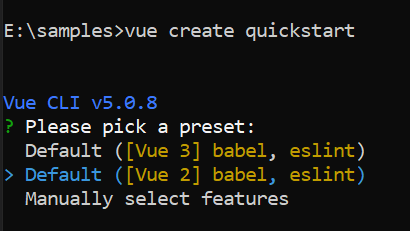Getting Started with the Vue Range navigator Component in Vue 2
25 Apr 20258 minutes to read
This article provides a step-by-step guide for setting up a Vue 2 project using Vue-CLI and integrating the Syncfusion® Vue Range navigator component
Prerequisites
System requirements for Syncfusion® Vue UI components
Dependencies
Below is the list of minimum dependencies required to use the range navigator component.
|-- @syncfusion/ej2-vue-charts
|-- @syncfusion/ej2-base
|-- @syncfusion/ej2-data
|-- @syncfusion/ej2-pdf-export
|-- @syncfusion/ej2-file-utils
|-- @syncfusion/ej2-compression
|-- @syncfusion/ej2-navigations
|-- @syncfusion/ej2-calendars
|-- @syncfusion/ej2-vue-base
|-- @syncfusion/ej2-svg-baseSetting up the Vue 2 project
To generate a Vue 2 project using Vue-CLI, use the vue create command. Follow these steps to install Vue CLI and create a new project:
npm install -g @vue/cli
vue create quickstart
cd quickstart
npm run serveor
yarn global add @vue/cli
vue create quickstart
cd quickstart
yarn run serveWhen creating a new project, choose the option Default ([Vue 2] babel, eslint) from the menu.

Once the quickstart project is set up with default settings, proceed to add Syncfusion® components to the project.
Add Syncfusion® Vue packages
Syncfusion® packages are available at npmjs.com. To use Vue components, install the required npm package.
This article uses the Vue Range navigator component as an example. Install the @syncfusion/ej2-vue-charts package by running the following command:
npm install @syncfusion/ej2-vue-charts --saveor
yarn add @syncfusion/ej2-vue-chartsThe –save will instruct NPM to include the range navigator package inside of the
dependenciessection of thepackage.json.
Add Syncfusion® Vue component
Follow the below steps to add the Vue Message component:
1. First, import and register the Message component in the script section of the src/App.vue file.
<script>
import { RangeNavigatorComponent } from '@syncfusion/ej2-vue-charts';
export default {
components: {
'ejs-rangenavigator': RangeNavigatorComponent
}
}
</script>2. In the template section, define Range navigator component.
<template>
<div id="app">
<ejs-rangenavigator></ejs-rangenavigator>
</div>
</template>Here is the summarized code for the above steps in the src/App.vue file:
<template>
<div id="app">
<ejs-rangenavigator></ejs-rangenavigator>
</div>
</template>
<script>
import { RangeNavigatorComponent } from '@syncfusion/ej2-vue-charts';
export default {
name: "App",
components: {
'ejs-rangenavigator': RangeNavigatorComponent
},
data() {
return {
}
}
}
</script>Run the project
To run the project, use the following command:
npm run serveor
yarn run serveModule Injection
To create range navigator with additional features, inject the required modules. The following modules are used to extend rangenavigator’s basic functionality.
•AreaSeries - Inject this module to use area series.
•DateTime - Inject this module to use date time axis.
•RangeTooltip - Inject this module to show the tooltip.
These modules should be injected to the provide section as follows,
import { RangeNavigatorComponent, AreaSeries, DateTime, RangeTooltip } from "@syncfusion/ej2-vue-charts";
export default {
components: {
'ejs-rangenavigator': RangeNavigatorComponent
},
provide: {
rangeNavigator: [AreaSeries, DateTime, RangeTooltip]
}
};
</script>Populate Range Navigator with Data
Now, we are going to provide data to the range navigator. Add a series object to the range navigator by using series property. Now map the field names x and y in the JSON data to the xName and yName properties of the series, then set the JSON data to dataSource property. Since the JSON contains Datetime data, set the valueType range Navigator to Category. By default, the axis valueType is Numeric.
<template>
<div id="app">
<ejs-rangenavigator :valueType='valueType' :value='value' :labelFormat='labelFormat'>
<e-rangenavigator-series-collection>
<e-rangenavigator-series :dataSource='data' type='Area' xName='x' yName='y' width=2>
</e-rangenavigator-series>
</e-rangenavigator-series-collection>
</ejs-rangenavigator>
</div>
</template>
<script>
import { RangeNavigatorComponent, RangenavigatorSeriesDirective, RangenavigatorSeriesCollectionDirective, AreaSeries, DateTime } from "@syncfusion/ej2-vue-charts";
import { bitCoinData } from "./default_data.js";
export default {
name: "App",
components: {
'ejs-rangenavigator': RangeNavigatorComponent,
'e-rangenavigator-series': RangenavigatorSeriesDirective,
'e-rangenavigator-series-collection': RangenavigatorSeriesCollectionDirective
},
data() {
return {
valueType: 'DateTime',
value: [new Date('2017-09-01'), new Date('2018-02-01')],
labelFormat: 'MMM-yy',
data: bitCoinData
};
},
provide: {
rangeNavigator: [DateTime, AreaSeries]
}
};
</script>Enable Tooltip
The tooltip is useful to show the selected data. You can enable tooltip by setting the enable property as true in tooltip object and by injecting RangeTooltip module using provide method.
<template>
<div id="app">
<ejs-rangenavigator :valueType='valueType' :value='value' :labelFormat='labelFormat' :tooltip='tooltip'>
<e-rangenavigator-series-collection>
<e-rangenavigator-series :dataSource='data' type='Area' xName='x' yName='y' width=2>
</e-rangenavigator-series>
</e-rangenavigator-series-collection>
</ejs-rangenavigator>
</div>
</template>
<script>
import { RangeNavigatorComponent, RangenavigatorSeriesDirective, RangenavigatorSeriesCollectionDirective, AreaSeries, DateTime, RangeTooltip } from "@syncfusion/ej2-vue-charts";
import { bitCoinData } from "./default_data.js";
export default {
name: "App",
components: {
'ejs-rangenavigator': RangeNavigatorComponent,
'e-rangenavigator-series': RangenavigatorSeriesDirective,
'e-rangenavigator-series-collection': RangenavigatorSeriesCollectionDirective
},
data() {
return {
valueType: 'DateTime',
value: [new Date('2017-09-01'), new Date('2018-02-01')],
tooltip: { enable: true, displayMode: "Always", format: "MM/dd/yyyy" },
labelFormat: 'MMM-yy',
data: bitCoinData
};
},
provide: {
rangeNavigator: [DateTime, AreaSeries, RangeTooltip]
}
};
</script>